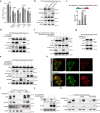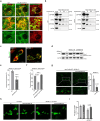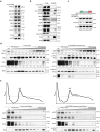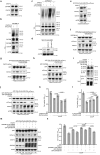Stalled translation by mitochondrial stress upregulates a CNOT4-ZNF598 ribosomal quality control pathway important for tissue homeostasis
- PMID: 38388640
- PMCID: PMC10883933
- DOI: 10.1038/s41467-024-45525-3
Stalled translation by mitochondrial stress upregulates a CNOT4-ZNF598 ribosomal quality control pathway important for tissue homeostasis
Abstract
Translational control exerts immediate effect on the composition, abundance, and integrity of the proteome. Ribosome-associated quality control (RQC) handles ribosomes stalled at the elongation and termination steps of translation, with ZNF598 in mammals and Hel2 in yeast serving as key sensors of translation stalling and coordinators of downstream resolution of collided ribosomes, termination of stalled translation, and removal of faulty translation products. The physiological regulation of RQC in general and ZNF598 in particular in multicellular settings is underexplored. Here we show that ZNF598 undergoes regulatory K63-linked ubiquitination in a CNOT4-dependent manner and is upregulated upon mitochondrial stresses in mammalian cells and Drosophila. ZNF598 promotes resolution of stalled ribosomes and protects against mitochondrial stress in a ubiquitination-dependent fashion. In Drosophila models of neurodegenerative diseases and patient cells, ZNF598 overexpression aborts stalled translation of mitochondrial outer membrane-associated mRNAs, removes faulty translation products causal of disease, and improves mitochondrial and tissue health. These results shed lights on the regulation of ZNF598 and its functional role in mitochondrial and tissue homeostasis.
© 2024. The Author(s).
Conflict of interest statement
B.L. is a co-founder and serves on the Scientific Advisory Board of Cerepeut, Inc. The remaining authors declare no competing interests.
Figures







Similar articles
-
A distinct mammalian disome collision interface harbors K63-linked polyubiquitination of uS10 to trigger hRQT-mediated subunit dissociation.Nat Commun. 2022 Oct 27;13(1):6411. doi: 10.1038/s41467-022-34097-9. Nat Commun. 2022. PMID: 36302773 Free PMC article.
-
Ribosomal collision is not a prerequisite for ZNF598-mediated ribosome ubiquitination and disassembly of ribosomal complexes by ASCC.Nucleic Acids Res. 2024 May 8;52(8):4627-4643. doi: 10.1093/nar/gkae087. Nucleic Acids Res. 2024. PMID: 38366554 Free PMC article.
-
Collided ribosomes form a unique structural interface to induce Hel2-driven quality control pathways.EMBO J. 2019 Mar 1;38(5):e100276. doi: 10.15252/embj.2018100276. Epub 2019 Jan 4. EMBO J. 2019. PMID: 30609991 Free PMC article.
-
Ribosomal Stalling During Translation: Providing Substrates for Ribosome-Associated Protein Quality Control.Annu Rev Cell Dev Biol. 2017 Oct 6;33:343-368. doi: 10.1146/annurev-cellbio-111315-125249. Epub 2017 Jul 17. Annu Rev Cell Dev Biol. 2017. PMID: 28715909 Review.
-
Mechanisms of Translation-coupled Quality Control.J Mol Biol. 2024 Mar 15;436(6):168496. doi: 10.1016/j.jmb.2024.168496. Epub 2024 Feb 15. J Mol Biol. 2024. PMID: 38365086 Review.
Cited by
-
Mechanochemical forces regulate the composition and fate of stalled nascent chains.bioRxiv [Preprint]. 2024 Oct 14:2024.08.02.606406. doi: 10.1101/2024.08.02.606406. bioRxiv. 2024. PMID: 39131335 Free PMC article. Preprint.
-
Upstream open reading frames buffer translational variability during Drosophila evolution and development.Elife. 2025 Jun 6;14:RP104074. doi: 10.7554/eLife.104074. Elife. 2025. PMID: 40478227 Free PMC article.
-
Translation stalling induced mitochondrial entrapment of ribosomal quality control related proteins offers cancer cell vulnerability.Res Sq [Preprint]. 2024 Sep 13:rs.3.rs-4899860. doi: 10.21203/rs.3.rs-4899860/v1. Res Sq. 2024. PMID: 39315278 Free PMC article. Preprint.
-
Ubiquitin-dependent translation control mechanisms: Degradation and beyond.Cell Rep. 2024 Dec 24;43(12):115050. doi: 10.1016/j.celrep.2024.115050. Epub 2024 Dec 10. Cell Rep. 2024. PMID: 39661518 Free PMC article. Review.
-
Ribosome Quality Control mitigates the cytotoxicity of ribosome collisions induced by 5-Fluorouracil.Nucleic Acids Res. 2024 Nov 11;52(20):12534-12548. doi: 10.1093/nar/gkae849. Nucleic Acids Res. 2024. PMID: 39351862 Free PMC article.
References
MeSH terms
Substances
Grants and funding
LinkOut - more resources
Full Text Sources
Molecular Biology Databases

